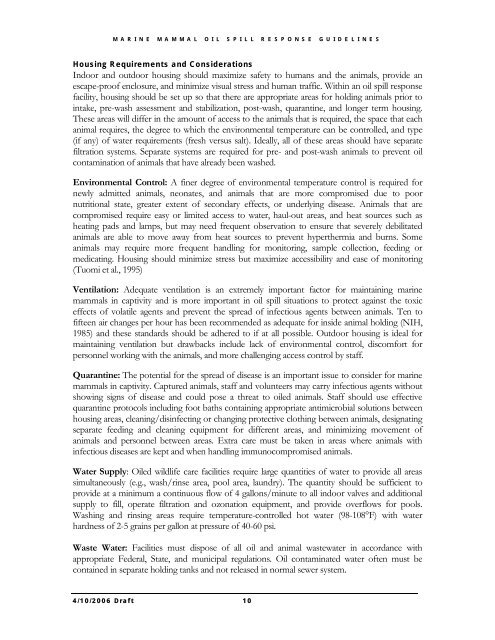Volume III, Appendices EM - National Marine Fisheries Service ...
Volume III, Appendices EM - National Marine Fisheries Service ...
Volume III, Appendices EM - National Marine Fisheries Service ...
Create successful ePaper yourself
Turn your PDF publications into a flip-book with our unique Google optimized e-Paper software.
MARINE MAMMAL OIL SPILL RESPONSE GUIDELINES<br />
Housing Requirements and Considerations<br />
Indoor and outdoor housing should maximize safety to humans and the animals, provide an<br />
escape-proof enclosure, and minimize visual stress and human traffic. Within an oil spill response<br />
facility, housing should be set up so that there are appropriate areas for holding animals prior to<br />
intake, pre-wash assessment and stabilization, post-wash, quarantine, and longer term housing.<br />
These areas will differ in the amount of access to the animals that is required, the space that each<br />
animal requires, the degree to which the environmental temperature can be controlled, and type<br />
(if any) of water requirements (fresh versus salt). Ideally, all of these areas should have separate<br />
filtration systems. Separate systems are required for pre- and post-wash animals to prevent oil<br />
contamination of animals that have already been washed.<br />
Environmental Control: A finer degree of environmental temperature control is required for<br />
newly admitted animals, neonates, and animals that are more compromised due to poor<br />
nutritional state, greater extent of secondary effects, or underlying disease. Animals that are<br />
compromised require easy or limited access to water, haul-out areas, and heat sources such as<br />
heating pads and lamps, but may need frequent observation to ensure that severely debilitated<br />
animals are able to move away from heat sources to prevent hyperthermia and burns. Some<br />
animals may require more frequent handling for monitoring, sample collection, feeding or<br />
medicating. Housing should minimize stress but maximize accessibility and ease of monitoring<br />
(Tuomi et al., 1995)<br />
Ventilation: Adequate ventilation is an extremely important factor for maintaining marine<br />
mammals in captivity and is more important in oil spill situations to protect against the toxic<br />
effects of volatile agents and prevent the spread of infectious agents between animals. Ten to<br />
fifteen air changes per hour has been recommended as adequate for inside animal holding (NIH,<br />
1985) and these standards should be adhered to if at all possible. Outdoor housing is ideal for<br />
maintaining ventilation but drawbacks include lack of environmental control, discomfort for<br />
personnel working with the animals, and more challenging access control by staff.<br />
Quarantine: The potential for the spread of disease is an important issue to consider for marine<br />
mammals in captivity. Captured animals, staff and volunteers may carry infectious agents without<br />
showing signs of disease and could pose a threat to oiled animals. Staff should use effective<br />
quarantine protocols including foot baths containing appropriate antimicrobial solutions between<br />
housing areas, cleaning/disinfecting or changing protective clothing between animals, designating<br />
separate feeding and cleaning equipment for different areas, and minimizing movement of<br />
animals and personnel between areas. Extra care must be taken in areas where animals with<br />
infectious diseases are kept and when handling immunocompromised animals.<br />
Water Supply: Oiled wildlife care facilities require large quantities of water to provide all areas<br />
simultaneously (e.g., wash/rinse area, pool area, laundry). The quantity should be sufficient to<br />
provide at a minimum a continuous flow of 4 gallons/minute to all indoor valves and additional<br />
supply to fill, operate filtration and ozonation equipment, and provide overflows for pools.<br />
Washing and rinsing areas require temperature-controlled hot water (98-108°F) with water<br />
hardness of 2-5 grains per gallon at pressure of 40-60 psi.<br />
Waste Water: Facilities must dispose of all oil and animal wastewater in accordance with<br />
appropriate Federal, State, and municipal regulations. Oil contaminated water often must be<br />
contained in separate holding tanks and not released in normal sewer system.<br />
4/10/2006 Draf t 10
















